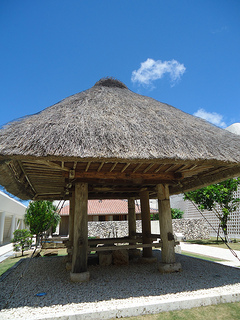Difference between revisions of "Takakura"
| Line 5: | Line 5: | ||
A ''takakura'' (lit. "tall/high storehouse") is a style of elevated storehouse, common throughout the Japanese archipelago in prehistoric and early historic times, and used in the [[Ryukyu Islands|Ryûkyû Islands]] into the 20th century. Similar structures are seen in Indonesia, and elsewhere throughout the Southeast and East Asian region. | A ''takakura'' (lit. "tall/high storehouse") is a style of elevated storehouse, common throughout the Japanese archipelago in prehistoric and early historic times, and used in the [[Ryukyu Islands|Ryûkyû Islands]] into the 20th century. Similar structures are seen in Indonesia, and elsewhere throughout the Southeast and East Asian region. | ||
| − | A Ryukyuan or [[Amami Islands]] storehouse is typically comprised of a single storage space with an extensive thatched roof, elevated off the ground on a series of wooden pillars. The elevation | + | A Ryukyuan or [[Amami Islands]] storehouse is typically comprised of a single storage space with an extensive thatched roof, elevated off the ground on a series of wooden pillars. The elevation allows breezes to pass underneath the building, protecting the goods stored inside from humidity; the ladder used for access can be taken away, helping prevent rats and other vermin from getting into the storehouse. The storehouse would typically be located at some distance from the village, in order to protect it (or the village) from potential fires. |
| + | |||
| + | An example at the [[Okinawa Prefectural Museum]], dating to the Shôwa period (1926-1989) and originally built on [[Okinoerabu Island]], is 6.45 meters in total height, elevated on six pillars separated by 3.16 meters in one direction, and 2.35 meters in the other direction, covering a total of 7.4 square meters, and able to store sixty paddy bags (''hyô''). | ||
{{stub}} | {{stub}} | ||
Revision as of 14:53, 4 January 2014

- For the monarch, see Emperor Takakura
- Japanese: 高倉 (takakura)
A takakura (lit. "tall/high storehouse") is a style of elevated storehouse, common throughout the Japanese archipelago in prehistoric and early historic times, and used in the Ryûkyû Islands into the 20th century. Similar structures are seen in Indonesia, and elsewhere throughout the Southeast and East Asian region.
A Ryukyuan or Amami Islands storehouse is typically comprised of a single storage space with an extensive thatched roof, elevated off the ground on a series of wooden pillars. The elevation allows breezes to pass underneath the building, protecting the goods stored inside from humidity; the ladder used for access can be taken away, helping prevent rats and other vermin from getting into the storehouse. The storehouse would typically be located at some distance from the village, in order to protect it (or the village) from potential fires.
An example at the Okinawa Prefectural Museum, dating to the Shôwa period (1926-1989) and originally built on Okinoerabu Island, is 6.45 meters in total height, elevated on six pillars separated by 3.16 meters in one direction, and 2.35 meters in the other direction, covering a total of 7.4 square meters, and able to store sixty paddy bags (hyô).
References
- Plaques on-site at Edo-Tokyo Open Air Architectural Museum and Okinawa Prefectural Museum.